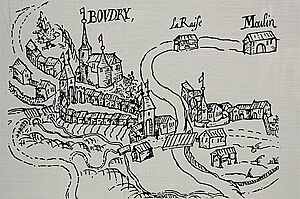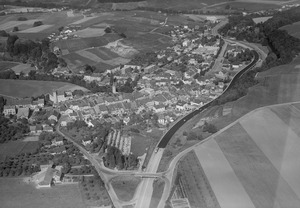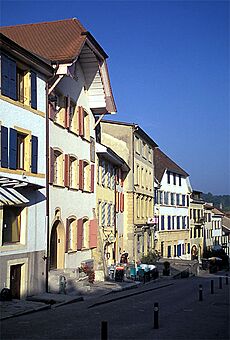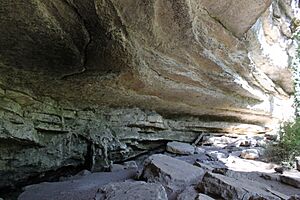Boudry facts for kids
Quick facts for kids
Boudry
|
||
|---|---|---|
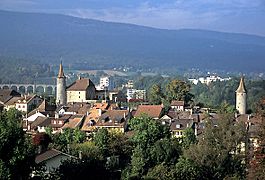 |
||
|
||
| Country | Switzerland | |
| Canton | Neuchâtel | |
| Area | ||
| • Total | 16.76 km2 (6.47 sq mi) | |
| Elevation | 460 m (1,510 ft) | |
| Population
(Dec 2020 )
|
||
| • Total | 6,193 | |
| • Density | 369.51/km2 (957.0/sq mi) | |
| Postal code |
2017
|
|
| Surrounded by | Bevaix, Bôle, Brot-Dessous, Chevroux (VD), Colombier, Cortaillod, Delley-Portalban (FR), Gletterens (FR), Gorgier, Neuchâtel, Noiraigue, Rochefort | |
| Twin towns | Voujeaucourt (France) | |
Boudry is a town in the canton of Neuchâtel in Switzerland. It's a place with a long history, from ancient settlements to modern industries.
Contents
Boudry's Long History
Boudry was first mentioned in official records way back in 1278. It was called Baudri then.
Ancient Times in Boudry
Many very old settlements have been found around Boudry. These include:
- Stilt houses from the Stone Age (Neolithic period) by Lake Neuchâtel.
- Caves like Abri Baume du Four, used by people from the Stone Age up to the La Tène period (around 450 BC to 50 BC).
- Ancient burial mounds (called tumuli) from the Hallstatt period (around 800 BC to 450 BC) in the Vallon de Vers.
- Two Celtic villages at Les Buchilles.
There are also items from the Roman era and a burial ground from the Burgundian people near the Areuse river.
Boudry in the Middle Ages
During the Middle Ages, Boudry was the main town of a region called the seigneurie of Boudry. This area included smaller villages like Pontareuse and Vermondins.
In 1313, the Counts of Neuchâtel bought the rights to this area. They already owned Boudry Castle, which was likely built before 1278. This purchase brought all these lands and the castle together under their rule.
The castle was often given to the daughters or wives of the Neuchâtel family. In 1343, Count Louis gave Boudry a special charter. This was like a set of rules that gave the town some rights, similar to the city of Neuchatel.
The town also gained the right to collect a special tax called Ungeld in 1369. A person called a Castellan managed the castle and had power over Boudry and nearby areas.
Changes in Religion
In the Middle Ages, the main church for Boudry was in Pontareuse. During the Protestant Reformation in 1534, the priest in Boudry decided to stay Roman Catholic. However, the areas around Boudry became Protestant. For a while, the church was shared by both groups.
Later, in the early 1600s, a new Reformed church was built in the center of Boudry for the Protestant residents.
Town Rights and Growth
In the 1500s, the people of Boudry gained more rights for their community.
- In 1510, they could build a town hall.
- In 1513, they built a mill.
- They got permission to rent out their shared lands and build houses outside the town walls.
- From 1540, they could choose two mayors to manage the town's lands.
- In 1548, they built a clock tower.
Boudry became the capital of its district in 1848.
Industry and Economy
In the 1700s, Boudry started to become an industrial town. Several factories were built, making things like straw hats, watches, and batteries. Later, a large machine tool factory opened.
Today, farming and viticulture (grape growing for wine) are important. Boudry has several wineries, a wine tasting cellar, and even a wine museum!
Boudry's Geography
Boudry covers about 16.8 square kilometers (about 6.5 square miles).
- About 23% of the land is used for farming.
- Over 63% is covered by forests.
- About 12% has buildings or roads.
- A small part is rivers or lakes.
Boudry is located on hills above the Areuse river. It includes the main town and smaller areas like Areuse, Trois-Rods, Perreux, and Champ-du-Moulin.
There was a plan to combine Boudry with two other towns, Bevaix and Cortaillod, but the people living there voted against it.
Boudry's Coat of Arms
The blazon (description) of Boudry's coat of arms is: Per fess or on a pale gules three chevrons argent and azure a fish naiant argent. This means it has a gold background with a red stripe that has three silver V-shapes, and a blue section with a silver fish swimming.
People of Boudry
Boudry has a population of about 5,000 people. About 22% of the people living there are from other countries.
Most people in Boudry speak French (about 86.5%). German is the second most common language, followed by Italian.
About 24% of the population are children and teenagers (0–19 years old). Most people (63%) are adults aged 20–64, and about 13% are seniors (over 64).
Many people in Boudry are married, but there are also many single people, widows, and divorced individuals. Most homes have about 2-3 people living in them.
The chart below shows how Boudry's population has changed over time:

Important Heritage Sites
The ancient settlement of La Baume Du Four is a very important heritage site in Switzerland. The whole town of Boudry, along with the areas of Areuse, Grandchamp, and Trois Rods, are part of the Inventory of Swiss Heritage Sites. This means they are protected for their historical and cultural value.
Boudry's Economy
In 2010, the unemployment rate in Boudry was 5.8%. Many people work in different types of jobs:
- Primary sector: About 57 people work in farming and forestry.
- Secondary sector: About 1,230 people work in manufacturing (making things) and construction (building things).
- Tertiary sector: About 1,572 people work in services, like sales, transportation, hotels, healthcare, and education.
Many people who live in Boudry travel to other towns for work, and some people travel into Boudry for their jobs. Most people use private cars to get to work, but some use public transportation.
Religion in Boudry
Based on a 2000 survey:
- About 31% of the people were Roman Catholic.
- About 39% belonged to the Swiss Reformed Church (Protestant).
- Smaller numbers of people belonged to other Christian churches, Islamic, or Jewish faiths.
- About 19% of the population did not belong to any church or were atheist.
Education in Boudry
Many adults in Boudry have completed higher education. About 37% have finished high school, and 12.5% have gone on to university or other higher education.
In the canton of Neuchâtel, children usually go to two years of non-mandatory kindergarten, then five years of primary school. After that, they go to secondary school for four years.
In 2010-2011, Boudry had 5 kindergarten classes with 100 students and 15 primary classes with 282 students. Some students from Boudry go to schools in other towns, and some students from other towns come to school in Boudry.
Famous People from Boudry
- Jean-Paul Marat (1743–1793): A famous French thinker, doctor, and politician during the French Revolution.
- Philippe Suchard (1797–1884): A Swiss chocolate maker who created the famous Milka chocolate.
- Pierre Bovet (1878–1965): A Swiss psychologist and educator.
See also
 In Spanish: Boudry para niños
In Spanish: Boudry para niños





